https://ospreypublishing.com/thisweekhistory/
An extract from Campaign 86: The Armada Campaign 1588 The Great Enterprise against England
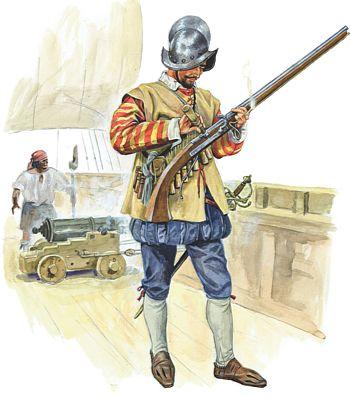
Fireships off Calais
Early on 8 August, Lord Howard's fireship attack drove the Spanish Armada from its anchorage off Calais. Most ships had to abandon their best and heaviest anchors as they manoeuvred rapidly to escape the threat and so were unable to return to the French coast where it had been planned that the Duke of Parma's invasion force would board. The Spanish were now widely scattered with the English fleet poised to windward and about to engage for the final, decisive battle of Gravelines. Superior English gunnery and a change in the wind ultimately overcame determined resistance and the Armada was driven up into the North Sea to sail home round Scotland. It was still intact as a fleet and a threat for the future, but in September Atlantic storms sweeping onto the west coast of Ireland destroyed around 45 of the 110 ships that had set sail from Lisbon five months earlier. Philip II did plan a second attempt to invade England with a new Armada, but, in 1596 and 1597, bad weather again defeated him and preserved the Reformation.
Further reading
Campaign 86: The Armada Campaign 1588 The Great Enterprise against England (see extract) is a detailed and gripping account of the 10 days of action between the first sighting of the Armada off the Devon coast and the battle at Gravelines and also covers the build-up to the invasion and the aftermath of its failure, all in the context of the national and religious politics of the time, and naval technology, tactics and strategy. Elite 15: The Armada Campaign 1588 focuses on the organisation, troops and equipment of the opposing sides while Elite 70:Elizabethan Sea Dogs 1560-1605 (extract below) goes into more detail on the swashbuckling English sea captains of the era, notably Drake, Grenville, Hawkins and Frobisher who were all involved in the action against the Armada. It also includes background on the Elizabethan art of war and on the ships that defeated the Armada.
Further reading
Campaign 86: The Armada Campaign 1588 The Great Enterprise against England (see extract) is a detailed and gripping account of the 10 days of action between the first sighting of the Armada off the Devon coast and the battle at Gravelines and also covers the build-up to the invasion and the aftermath of its failure, all in the context of the national and religious politics of the time, and naval technology, tactics and strategy. Elite 15: The Armada Campaign 1588 focuses on the organisation, troops and equipment of the opposing sides while Elite 70:Elizabethan Sea Dogs 1560-1605 (extract below) goes into more detail on the swashbuckling English sea captains of the era, notably Drake, Grenville, Hawkins and Frobisher who were all involved in the action against the Armada. It also includes background on the Elizabethan art of war and on the ships that defeated the Armada.
An extract from Campaign 86: The Armada Campaign 1588 The Great Enterprise against England

Fireships off Calais
Late on Saturday night Howard sought the advice of Sir William Winter of the Vanguard, who reportedly suggested using fireships against the Spanish fleet. Howard was enamoured with the idea, and early the following morning he called his senior commanders together for a council of war on board the Ark Royal. Seymour, Drake, Hawkins and Frobisher approved the plan, and its execution was set for midnight that night. Howard sent Sir Henry Palmer of the Antelope to Dover to commandeer suitable vessels and combustible materials. Seymour had already gathered a store of brushwood and pitch at Dover for exactly this purpose. The freshening south-westerly wind made their arrival before midnight unlikely, so Howard was forced to sacrifice vessels from his own fleet. After further consultation with his squadron commanders, eight armed merchantmen were selected for conversion into fireships.
The ships selected were the Bark Talbot and Thomas Drake (both of 200 tons), the Hope of Plymouth (180 tons), the Bark Bond and Cure's Ship (both of 150 tons), the Bear Yonge (140 tons), the small Elizabeth of Lowestoft (90 tons) and one other even smaller vessel. For the rest of the day carpenters worked on the vessels, strengthening rigging, altering or removing the gunports and possibly cutting exit ports in the stern for the skeleton crew to escape through. Other seamen gathered all the combustible materials which could be found in the fleet (old sails, cordage, hemp, tar, pitch, etc.), and soaked the ships in oil. They also loaded and double-shotted the guns, so that when the heat ignited the charges, they would fire into the enemy fleet and increase the confusion. A handful of volunteers were selected to steer each ship towards the Armada. At the last moment the tiller or whipstaff would be lashed and the crew would escape over the stern into a waiting longboat which was towed behind each fireship.
While the English were busy preparing for their night-time attack, the Duke of Medina Sidonia was trying to determine his next move. Although he had sent two messages to Parma as the Armada sailed up the Channel, he had not received any reply. On 2 August Parma was informed that the Armada had left La Coruña, but he only heard it was approaching Calais on 5 August, the day before the fleet anchored in Calais Roads. For the first time, the two commanders could communicate with each other. A messenger reported that the Duke of Parma was still at his headquarters in Bruges, and his troops and stores were still in their camps. They had not even started to board the invasion barges which would transport them to Kent. Meanwhile word also came of a Dutch coastal squadron blockading Dunkirk and Nieuport, making it difficult for Parma to put to sea. The barges would have to creep towards Gravelines using the Flemish network of small canals and rivers, and it was estimated that the process would take anything up to two weeks. Medina Sidonia's fleet was in an unsheltered anchorage off a neutral port, with a powerful English fleet to windward and the mass of sandbanks known as the Banks of Flanders to leeward. It was an unenviable position, but he had little option but to remain in place and wait for Parma.
The French Governor of Calais was Giraud de Mauleon, Seigneur de Gourdan. As a Catholic who had lost a leg fighting the English 30 years earlier, his sympathies lay with Spain. Presents were exchanged between the governor and Medina Sidonia, and a Spanish delegation went ashore to liaise with the French and buy provisions for the fleet. It was headed by the Duke of Ascoli, who also established firm lines of communication with Parma in Bruges. Throughout the day French boats ferried food and supplies out to the waiting Spanish ships, supervised by the Armada's paymaster-general, Don Jorge Manrique. That evening Don Jorge was ordered to ride to Bruges to persuade the Duke of Parma to speed up his embarkation.
During the evening the wind changed from the south-west to the west, the same direction as the tidal flow. That Sunday it was also a full moon, so the spring tides were at their strongest. Both the wind and the flood tide were therefore in the English favour, and as final preparations were made for the fireships, the rest of the fleet prepared for a naval attack on the Armada the following day. For his part Medina Sidonia placed a screen of light craft (carvels, pataches, falúas or zabras) to the west of his anchorage, between the Armada and the English fleet. Similar screening vessels were presumably deployed to the east, to prevent any surprise attack by the Dutch. Soon after midnight Spanish lookouts on these screening craft spotted two glowing ships heading towards them from the English fleet two miles away. What had happened was that the fireship attack had been launched on schedule, but on two of the eight vessels the fires had either been ignited prematurely or the vessels had proved particularly combustible. This gave the Spanish some advanced warning of the impending attack, and the alarm was raised.
To the Spanish, fireships had a particularly alarming association, since just over three years before, the Dutch rebels had launched an attack against a Spanish pontoon bridge across the River Schelde, near Antwerp. The Dutch fireships had been packed with explosives, and the resulting devastation destroyed the bridge and cost the lives of 800 Spanish soldiers. The Dutch engineer who had created them was known to have moved to England, and could well have been behind this attack. In fact the English fireships were far less lethal and consequently far less effective. Around midnight the flood tide moved east at three knots, and although they carried minimal sails, the fireships would be among the Armada within 15 or 20 minutes. The small screening ships managed to grapple and tow two of the eight vessels out of the path of the Armada, but the other six were presumably blazing too fiercely to approach. Medina Sidonia reacted swiftly to the threat, and issued the only sensible order he could. Pinnaces were sent through the fleet ordering the ships to cut their anchor cables, raise their sails and escape to seaward. He hoped that once the threat had passed, the Armada would be able to regroup and anchor in the same position again.
Subsequent English accounts have suggested that the Spanish panicked and fled, but this has since been refuted. Like almost all evolutions undertaken by the Armada, it was a seamanlike manoeuvre, accomplished with almost complete success. Of the mass of craft that made up the fleet, only one vessel collided with another in the darkness. The galleass San Lorenzo broke her rudder in the collision and spent the night trying to creep back towards Calais under oars. The remainder of the fleet avoided the fireships but were unable to regain their original anchorage in Calais Roads. The strong flood tide, combined with a seabed which provided poor holding meant that most of the ships were unable to anchor and they drifted to the north-east, towards Gravelines and the Banks of Flanders.
This turned out to be the single most decisive incident of the campaign. The Armada had been driven from its anchorage, and its ships had been forced to sacrifice their best and strongest anchors. These were irreplaceable, and the remaining smaller anchors would be unable to provide a purchase in the tidal waters off Calais. Although the Armada remained undamaged, it was scattered, and for the first time since the campaign began it was strung out over miles of sea; it had lost the tight defensive formation that had enabled it to cross the Channel in relative safety.
The loss of the anchorage also meant that the Armada was now unlikely to be able to rendezvous with the Duke of Parma. One English historian called the purchase of the eight fireships for just over £5,000 'the cheapest national investment the country has ever made'. It was also one of the most effective. The Spanish lay off some of the most dangerous coastal waters in Europe, and without anchors their position was precarious. Only five galleons managed to anchor in their original position, including Medina Sidonia's San Martín and Recalde's San Juan de Portugal. The rest of the Armada lay scattered in the darkness, and to windward the English fleet was preparing to fight the climactic battle of the campaign.
Hiszpańska Armada płynie do Anglii, rys. Bernard Finnegan Gribble, XIX w.
Adoracja w imię Jezusa albo sen Filipa II, mal. El Greco, 1578 – 1579
Królowa Anglii Elżbieta I, tzw. portret Armady z 1588 r.
Król Hiszpanii Filip II, mal. Anthonis van Dishorst Mor, XVI w.
Alegoryczny wizerunek Anglii i jej floty, rycina z dzieła Johna Dee, 1577 r.
Rozkazy Filipa II dla księcia Mediny Sidonii, dowódcy Armady
Alessandro Farnese, książę Parmy, hiszpański gubernator Niderlandów
Alonso Perez de Guzman ks. Medina Sidonia, dowódca Niezwyciężonej Armady
Francis Drake, portret z końca XVI w.
Charles Howard of Effingham, angielski Lord Admirał, miniatura z 1605 r.
Bitwa morska – prawdopodobnie pod Kadyksem w 1596 r., mal. Hendrick Vroom, poczatek XVII w.
Obrona Kadyksu przed atakiem eskadry Drake'a w 1587 r., mal. Francisco de Zurbaran, 1634 r.
Model hiszpańskiego galeonu „San Martin”
Przekrój angielskiego galeonu z epoki elżbietańskiej
Model angielskiego galeonu „Revenge”
Hiszpańska Niezwyciężona Armada płynie ku brzegom Anglii, rycina z epoki
Mapa z trasą Armady, ryc. Augustine Ryther, 1588 r.
Anglicy atakują Armadę koło wyspy Wight, 4 sierpnia 1588 r., rycina, XVII w.
Bój z Niezwyciężoną Armadą, mal. Nicholas Hilliard, 1588 r.
Bitwa Niezwyciężonej Armady, mal. Pierre Puget, koniec XVI w.
Martin Frobisher, angielski żeglarz, korsarz i dowódca floty, rycina z epoki
Pieczęć Francisa Drake'a z herbem szlacheckim nadanym w 1581 r.
Pedro de Valdez, kapitan hiszpańskiego galeonu „Nuestra Senora del Rosario”, poddaje się Francisowi Drake’owi 1 sierpnia 1588 r.
Angielski galeon „Vanguard” atakuje okręty hiszpańskie, rycina, XIX w. 2
Anglicy wypuszczają brandery na Armadę kotwiczącą pod Calais, szkoła francuska, XVI w.
Mapa z zaznaczonymi miejscami starć Armady z Anglikami, ryt. John Pine, 1739 r.
Angielski galeon „Ark Royal” oddaje salut na cześć Lorda ądmirała Charlesa Howarda, litografia, XIX w.
Angielscy dworacy i wojsko oczekują na brzegu na przybycie wroga, itografia, XIX w.
Filip II dostaje wieść o klęsce Armady, rys. John Seymour Lucas, 1923 r.
Medal angielski wybity dla upamiętnienia odparcia Armady, 1588 r.
Elżbieta I i Walter Raleigh, fragment malowidła z gmachu brytyjskiego parlamentu, mal. Alfred Kingsley Lawrence
By the mid-16th century, artillery had established itself as a necessary tool in naval warfare. It was still not the dominant weapon type, but instead formed part of an integrated range of weaponry. Evidence from the warship Mary Rose which sank in Portsmouth harbour in 1545 emphasises this integrated approach. She carried a mixture of ordnance, including large bronze pieces as well as wrought-iron breech-loading guns mounted on wooden beds. Swivel guns mounted on the ships rail provided close-range firepower, augmented by 'hackbutts' and 'arquebuses'. On board, archers outnumbered firearm-carrying infantry, while bills and other staff weapons were provided for use during a boarding action. To complete the array, firepots and other incendiary weapons were carried in limited numbers. The Mary Rose was designed primarily as a platform for close-range weaponry, and her ability to engage in a protracted artillery duel was minimal.
Naval tactics had developed by the middle of the century to take advantage of the revolution created by ship-borne artillery. Two theories had emerged, the more traditional based around using the ship as an integrated weapon and favouring boarding actions; the other, more revolutionary notion advocated using the artillery carried on board as the primary offensive weapon. The English, and to a lesser extent the Dutch and the French took full advantage of the introduction of reliable artillery to rethink their approach to naval warfare. Although circumstance largely dictated which approach was used, these nations tended to develop a doctrine based around the use of artillery as an offensive weapon. In short, the Spanish relied on boarding to win a sea battle, while their enemies preferred to keep their distance and rely on gunnery to win the fight.
During the Armada campaign, soldiers loaded the Spanish guns, and then a solitary gunner was left to man the artillery piece while the soldiers armed themselves with boarding weapons. The role of the soldiers and the swivel gunners was to engage enemy boarding parties immediately before two ships locked in combat. Artillery was fired one salvo at the same time, partly to sweep the decks of the enemy and partly to pound the forecastle and sterncastles of the enemy vessel, creating a breach through which assault parties could storm the enemy ship. This was the same tactic used in the days of the Mary Rose over 40 years earlier, and made no concessions to recent developments in gunnery. Spanish vessels did not rely on this form of combat to the exclusion of gunnery, and evidence from engagements as early as 1568 suggest that the Spanish could perform long-range fire if they chose to. During the attack on Filipo Strozzi's French fleet in the Azores in 1582, the Spaniards used gunnery to defeat their opponent, and tended to employ tactics developed by the galley fleets of the Mediterranean. During the Elizabethan period, they were clearly still writing the tactical manuals, and innovation and organisation were often more important than tactical doctrine.
The big advantage that the English enjoyed over the Spanish was that for the most part they used a four-wheeled gun carriage. It allowed the gun to be run up closer to the gun port, making the piece easier to aim or to traverse. Also, the gun's weight was distributed between four points, each of them a small truck wheel. The Spanish relied on two-wheeled carriages which resembled land guns, but with solid or almost solid wheels. On some vessels, these wheels could be as much as three feet high, making the piece unwieldy, and also distributing the weight onto three points (two wheels and a trail). Another significant innovation was that the English developed a simple system of blocks, ropes and tackles which allowed the guns to be pulled inboard by their own recoil, reloaded and then run out again with the minimum amount of effort. The same system was refined until it became the standard form of mounting and firing naval guns in the 17th century. By contrast, archaeological and historical evidence suggests that the Spanish, who lashed their guns to the hulls of their ships, had to untie the ropes, and then physically manhandle them inboard in order to reload. Another advantage of the truck carriage was space. While a typical English carriage was smaller than the gun itself, many Spanish carriages had long trails, making the gun and carriage a lengthy and unwieldy addition to an already crowded gundeck. During the Armada celebrations of 1988, two replicas were made and given to trained naval crews to operate. It was found that the same gun mounted on a replica Spanish carriage took about ten to 15 minutes to reload compared to the five minutes when mounted on the replica truck carriage. The four-wheeled truck carriage was present on the Mary Rose when she sank in 1545, so it was far from a new invention in 1588. The Spanish simply ignored the innovation, and continued to ignore it well into the 17th century. The remains of two-wheeled naval carriages were recovered from the wreck of the Spanish treasure galleon Nuestra Señora de Atocha, which wrecked in 1622.
Once these guns were fired, they had to be reloaded. The physical problems have already been discussed, but reloading had tactical implications as well. In a number of contemporary accounts of gunnery actions, vessels are said to have fired a broadside, then turned, presenting their bow or stern guns to the enemy and fired the other broadside after continuing to turn. This derived from the notion that in order to reload in safety, a ship would have to retire to a safe distance from the enemy, or alternatively, reload on the disengaged side while firing the rest of its armament at the enemy. The tactic used was similar to the carracole, a contemporary cavalry evolution, where a column of riders took turns to fire at the enemy, retiring to the rear rank to reload. It was not uncommon for warships to fight an enemy by sailing in a 'figure of eight', alternately firing each part of its heavy armament at the enemy while reloading on the disengaged side. These tactics were a far cry from the 'line of battle' actions fought from the late-17th century onwards.
The greatest sea battle of the century between rival fleets of sailing ships was fought at the end of the Spanish Armada campaign of 1588. The engagement at Gravelines was a loose mêlée, and was the exception rather than the rule, but the Armada campaign taken in its entirety demonstrates the two rival doctrines and their drawbacks. For the entire campaign, the Spanish maintained a dense formation, where each ship was supported by several others. In a number of occasions during the progress up the English Channel the Spanish broke the formation to rescue ships which had fallen behind, or to attack isolated groups of English ships. The English were unable to make any impression on the dense Armada formation. Gunnery alone seemed unable to break up an enemy fleet. It was only when the formation was broken that the English were able to gain a tactical advantage over their adversaries, and with their faster vessels and efficient artillery were able to concentrate on individual Spanish ships. Throughout the campaign the Spanish relied on their 'boarding action' tactic, but the English simply stayed out of the way, although often the two fleets came close enough to fire arquebuses at each other. The successes of many of the Elizabethan 'sea dogs' arose from their ability to understand the tactical problems facing both themselves and their opponents, and their skill in adapting these limitations to their advantage.
Angielski kaper John Hawkins rycina z XVI w.
|
Atak eskadry angielskiej Drake'a na San Domingo 1785 r.
|
sir Walter Raleigh
|
Francis Drake, portret ok. 1590 r.
|
|
|
Elżbieta I nobilituje Drake'a na pokładzie galeonu "Golden Hind" w 1581 r.
Rapier Filipa II
|


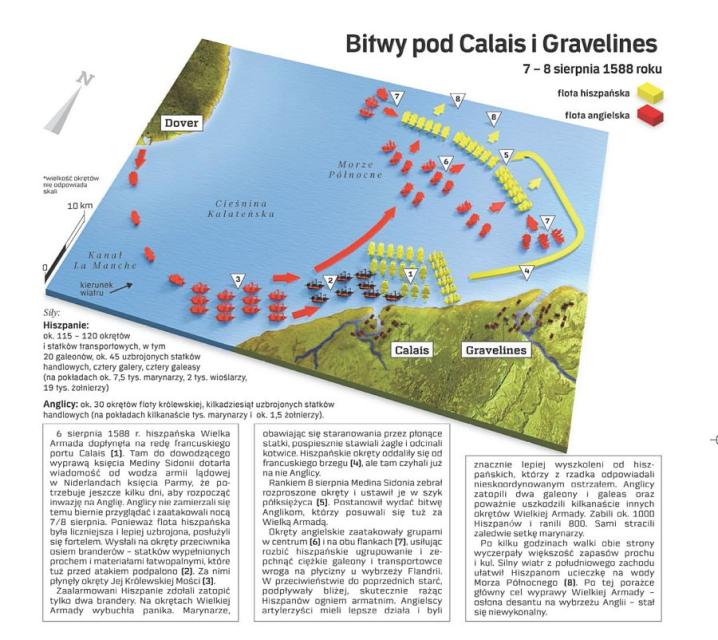
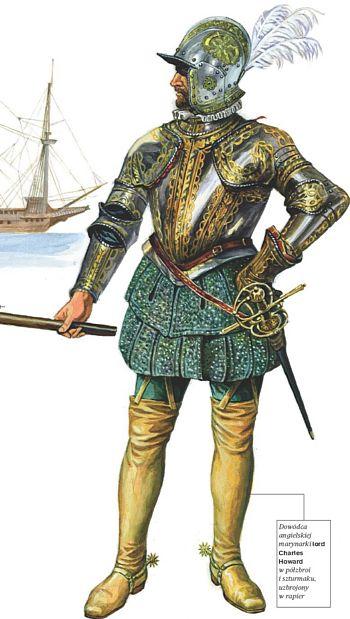
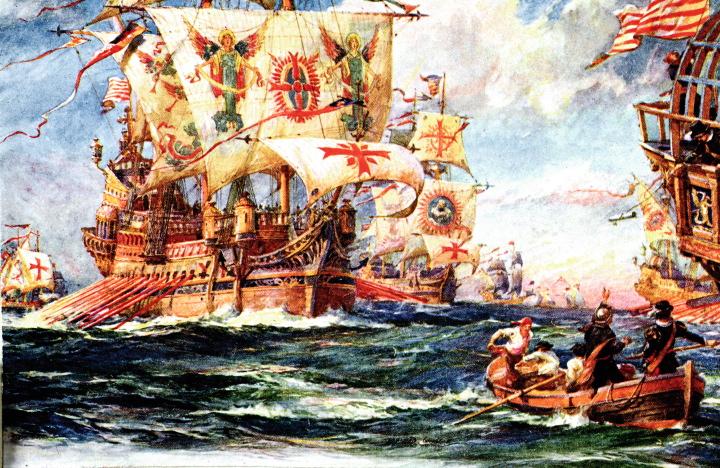
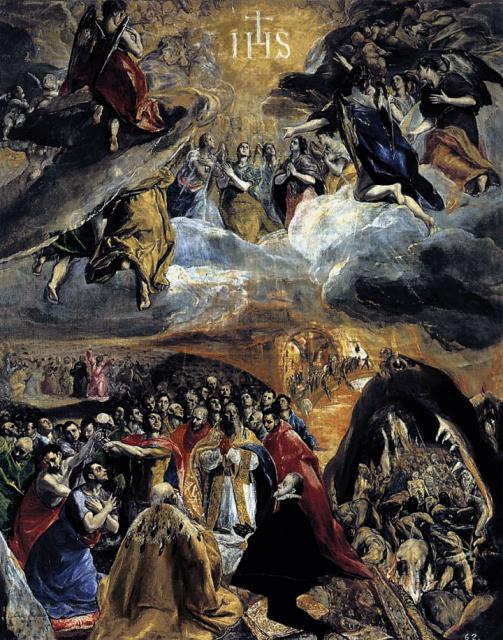
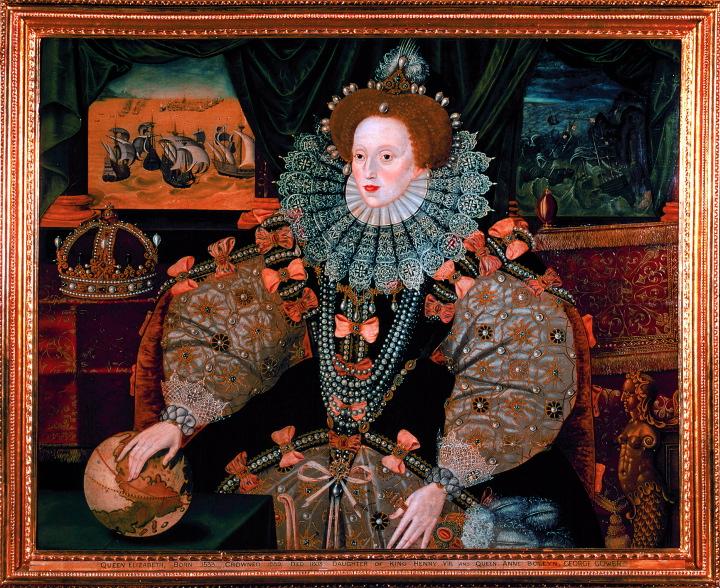
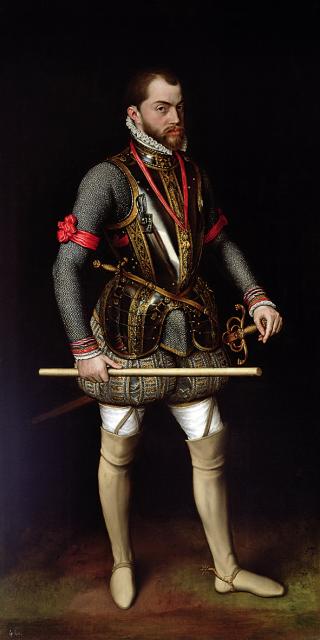
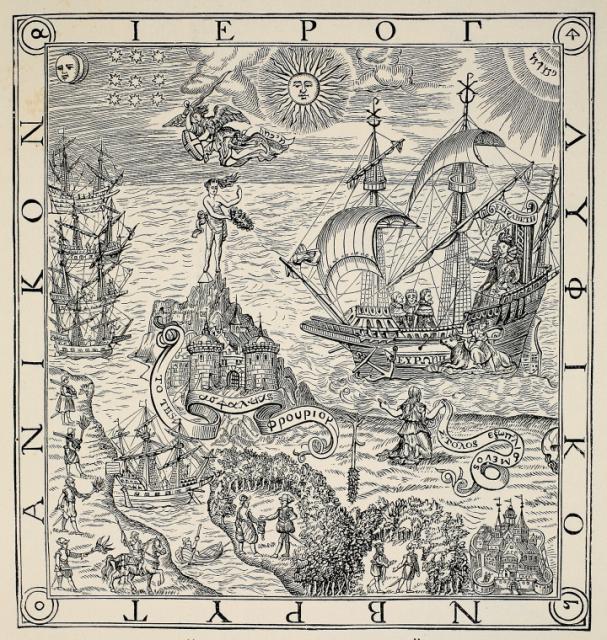
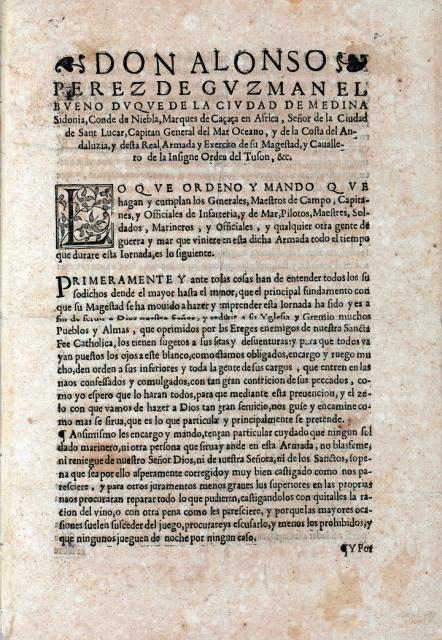
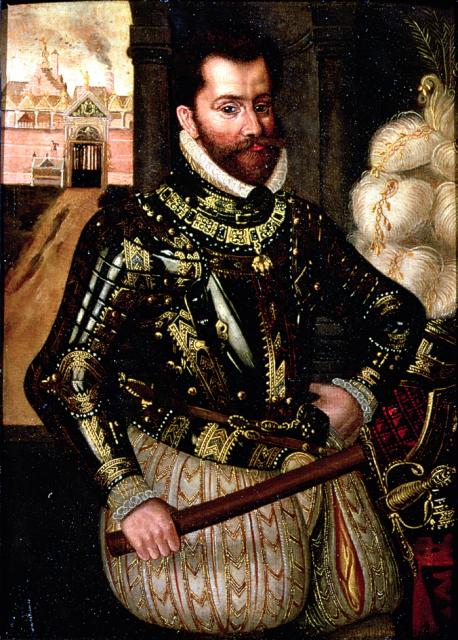
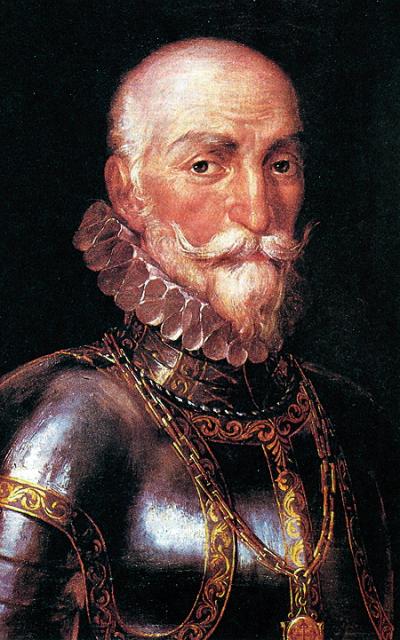
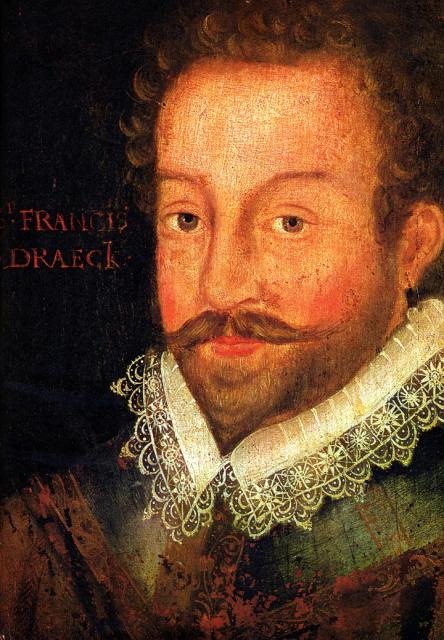
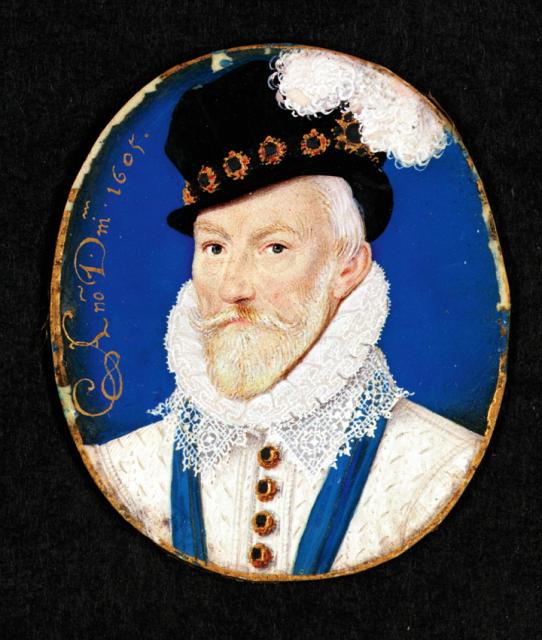
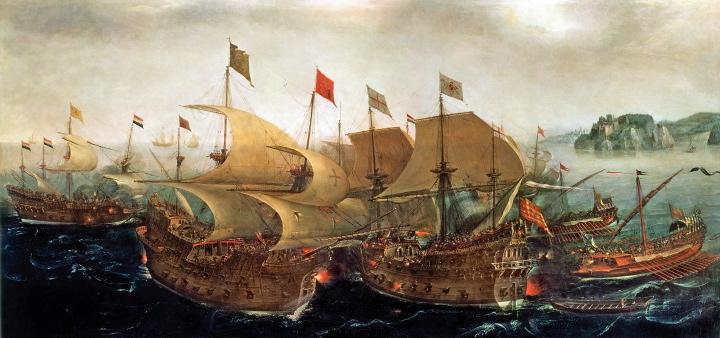
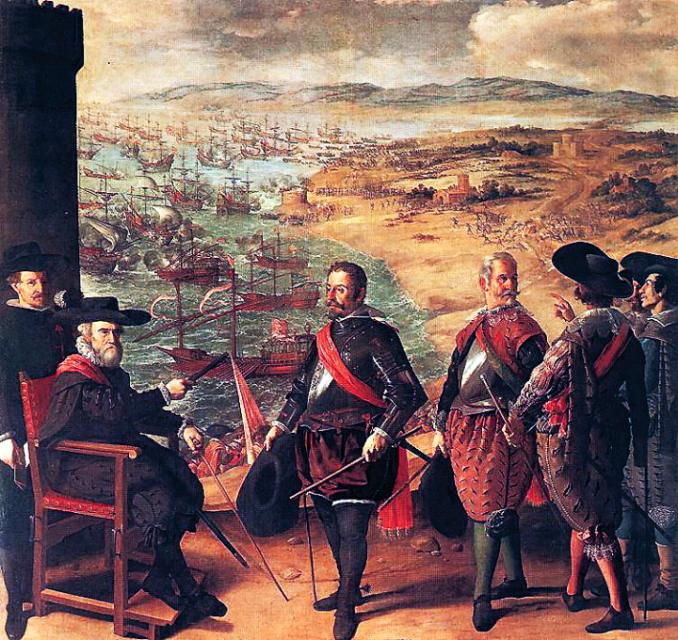
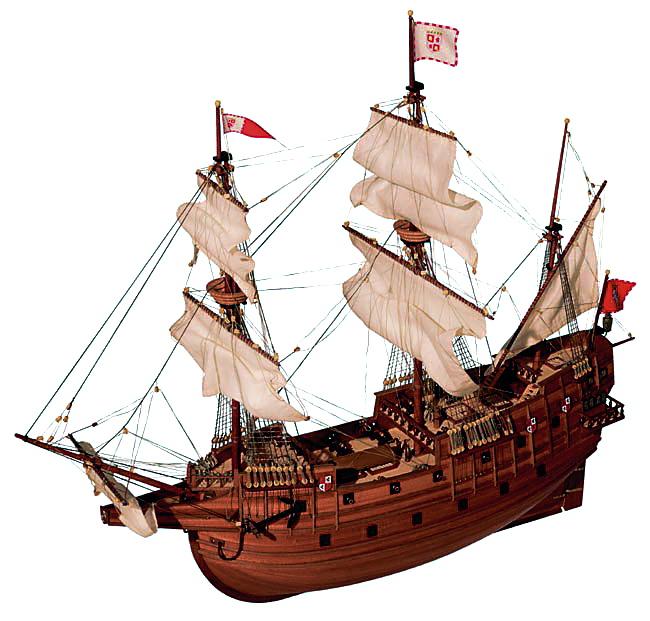
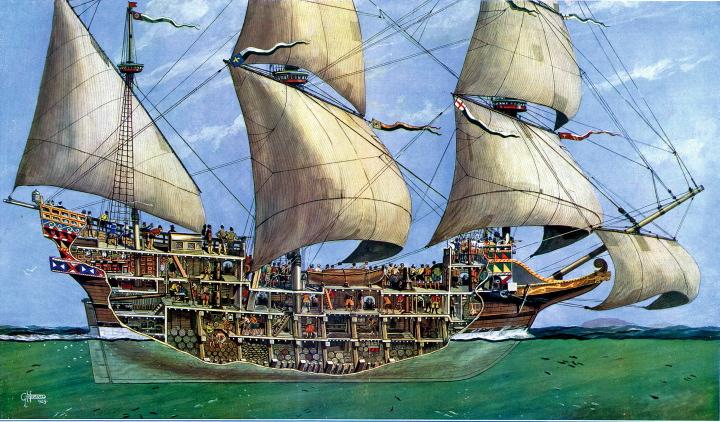

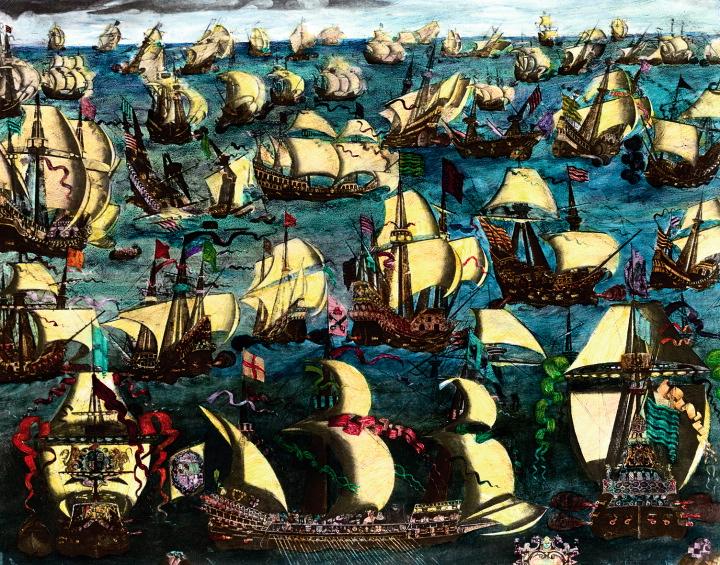
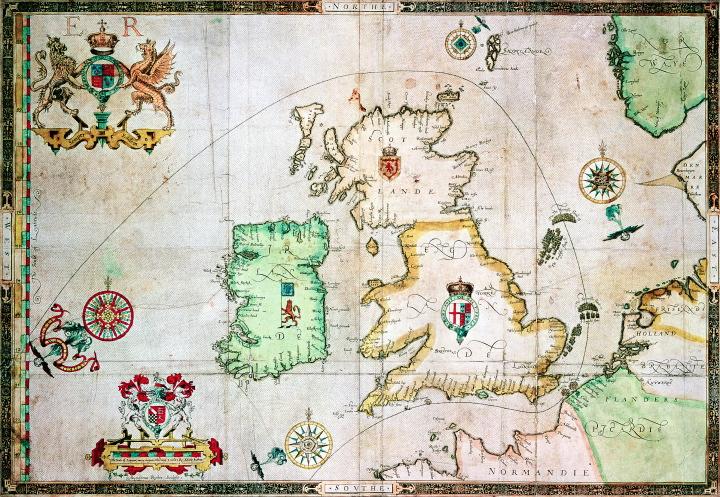


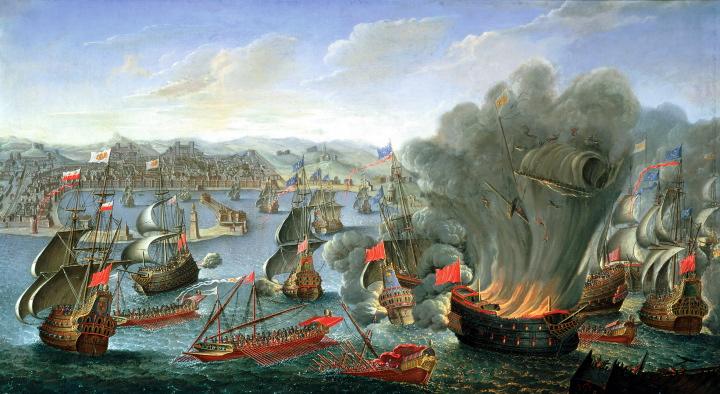
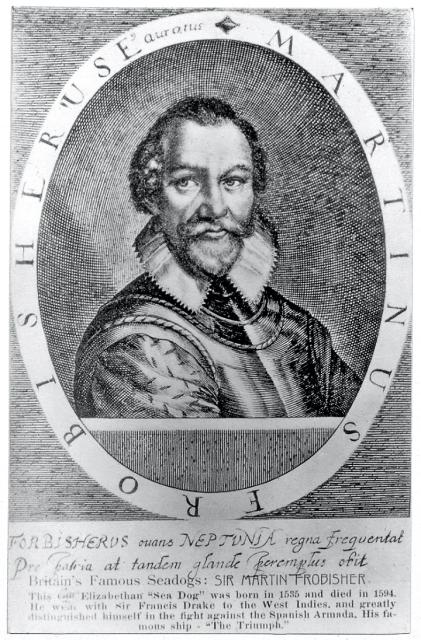
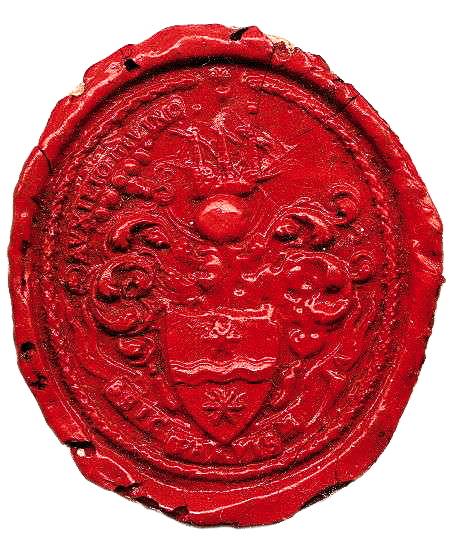
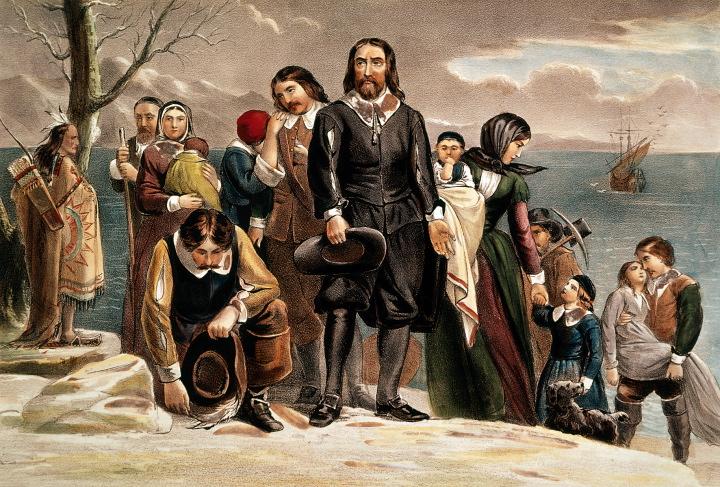
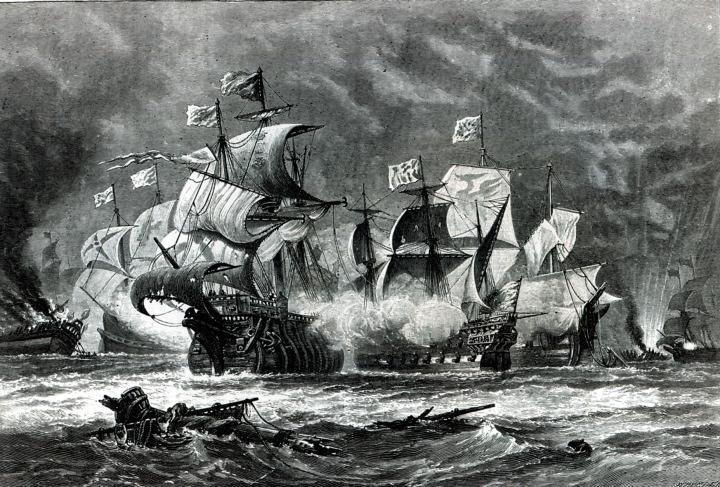

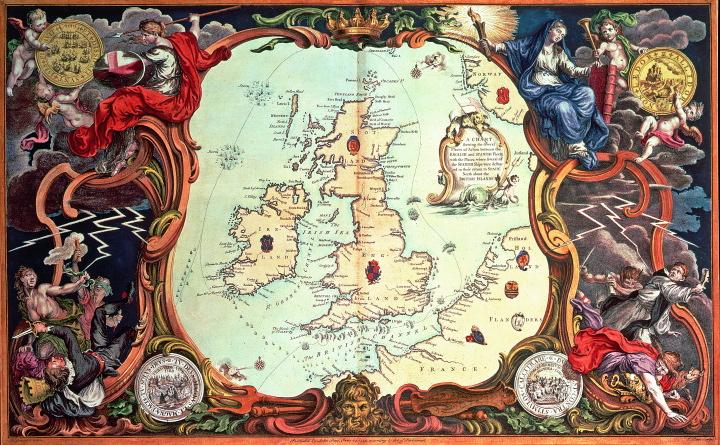
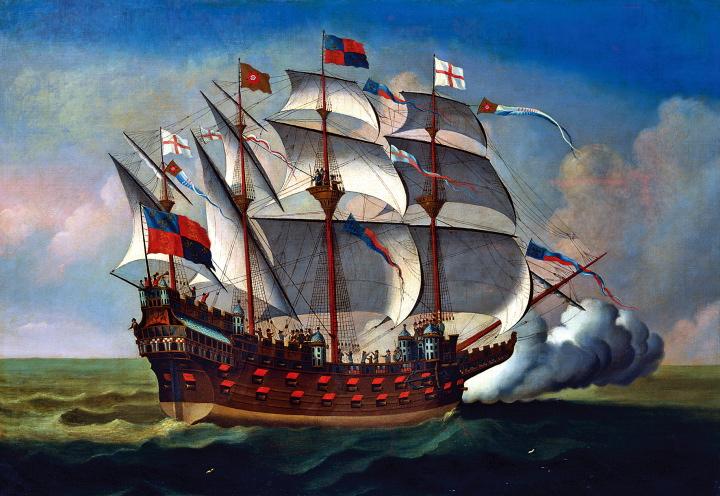
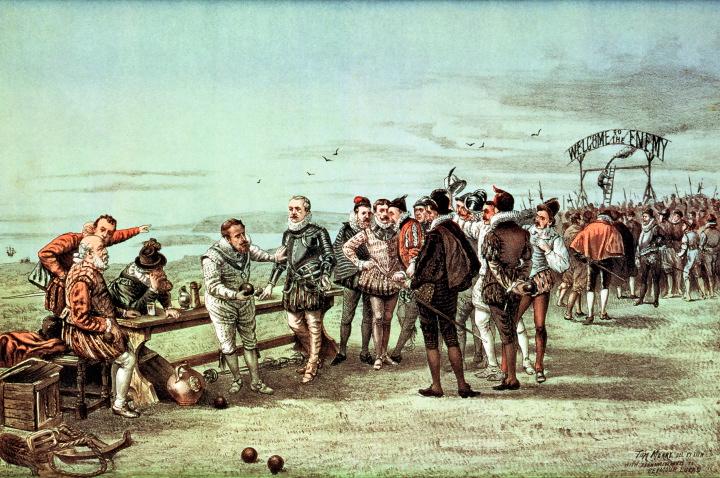

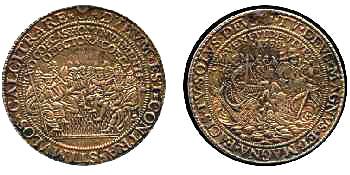
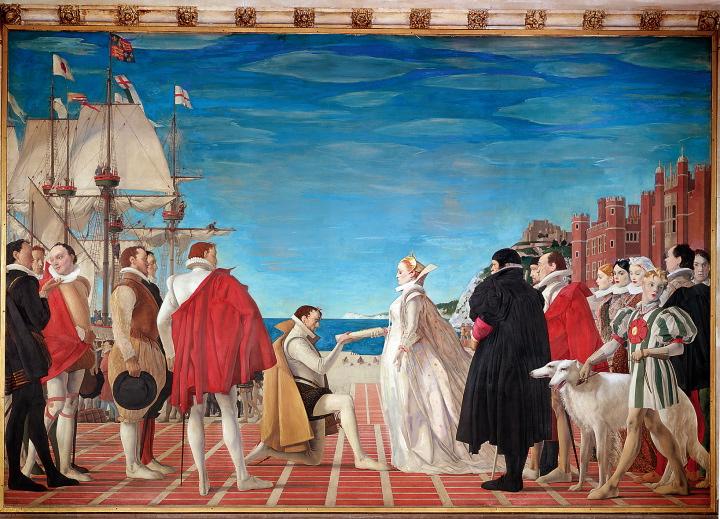

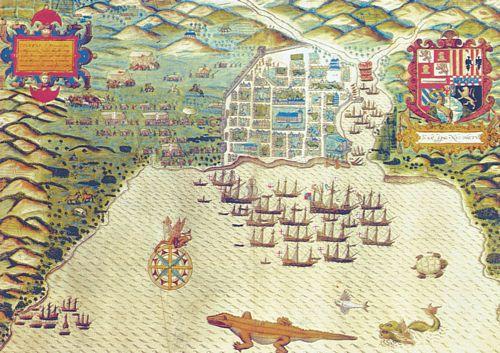
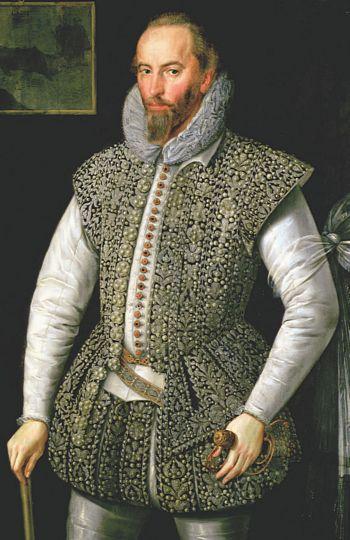
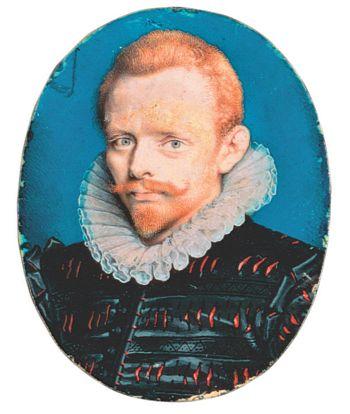
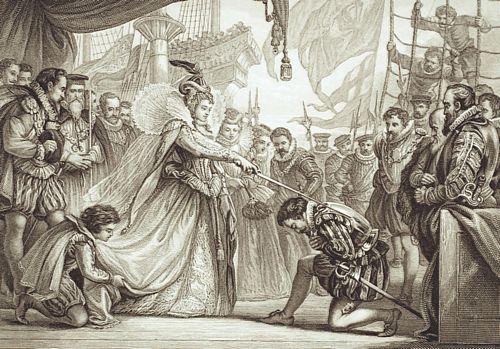
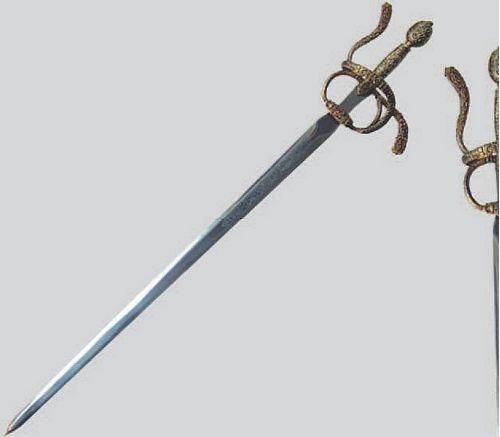
No comments:
Post a Comment